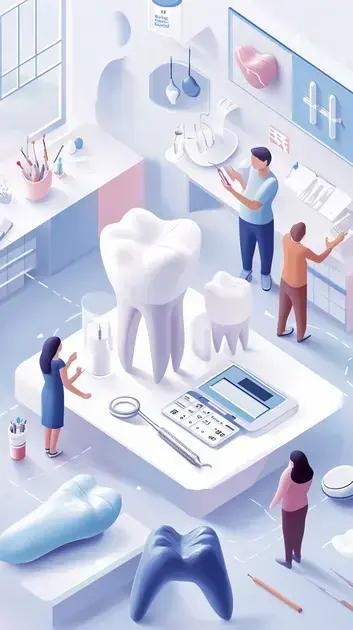4 Dental insurance and Compare the Best
Dental insurance is crucial for maintaining oral health and managing dental care costs. This guide explains different types of dental plans, how to select the best one, and what costs to expect. It dispels myths about dental insurance, highlighting its benefits for everyone, regardless of dental health. To maximize benefits, individuals should schedule regular check-ups, understand their coverage, and utilize preventive care, ensuring informed decisions for a healthy smile.
Dental insurance is a crucial part of maintaining your oral health, yet many people find themselves confused by the various options available. Whether you’re looking for affordable dental insurance or trying to understand the different types of coverage, this guide will break down everything you need to know about dental insurance. From the best dental insurance plans to navigating costs and maximizing your benefits, we’ve got you covered with expert insights and practical tips.
Table of Contents
ToggleUnderstanding Dental Insurance: Types and Coverage
Understanding dental insurance is essential for making informed decisions about your oral health care. At its core, dental insurance helps cover the costs associated with dental procedures, making it easier to maintain your smile without breaking the bank. There are several types of dental insurance plans available, each offering different coverage options.
1. Traditional Dental Insurance Plans: These plans typically cover a portion of the costs for preventive, basic, and major dental services. Preventive services often include routine check-ups and cleanings, while basic services might cover fillings and extractions. Major services, like crowns and root canals, are usually covered at a lower percentage.
2. Dental Health Maintenance Organizations (DHMOs): DHMOs offer a more managed approach to dental care. Members must choose a primary dentist and get referrals for specialists. While premiums are generally lower, you may have less flexibility in choosing providers. Coverage often includes preventive care and a set list of services at reduced costs.
3. Preferred Provider Organizations (PPOs): PPOs provide more flexibility in choosing dentists and specialists. They have a network of preferred providers, and while you can see out-of-network dentists, your out-of-pocket costs will be higher. PPO plans typically cover a wide range of services, including preventive, basic, and major treatments, often with a higher percentage of coverage for in-network providers.
4. Indemnity Dental Insurance: This type of plan allows you to visit any dentist without a network restriction. You pay upfront for services and then submit claims for reimbursement. Indemnity plans often have higher premiums but provide greater freedom in choosing your dental care providers.
Understanding these types of dental insurance plans is crucial for selecting the right coverage that meets your needs. By knowing what each plan offers, you can make an informed decision that ensures your dental health is well-protected. Remember, the best dental insurance is one that aligns with your specific dental needs and budget.
How to Choose the Best Dental Insurance Plan for Your Needs

Choosing the best dental insurance plan for your needs can feel overwhelming, but with a few key considerations, you can simplify the process. Here’s how to navigate the options and find a plan that works for you:
1. Assess Your Dental Needs: Start by evaluating your current dental health and any anticipated procedures. If you have ongoing dental issues or expect to need extensive work, look for plans that cover major services comprehensively. For those who primarily need preventive care, a plan focusing on routine check-ups and cleanings may suffice.
2. Understand Coverage Options: Different plans offer varying levels of coverage. Make sure to read the fine print and understand what services are included. Look for plans that cover preventive care at 100%, as this can save you money in the long run. Additionally, check the coverage percentages for basic and major services to ensure they align with your needs.
3. Compare Costs: Evaluate the premiums, deductibles, and out-of-pocket maximums for each plan. A lower premium might seem appealing, but it could come with higher deductibles or less coverage. Use a cost-benefit analysis to determine which plan offers the best value based on your expected dental care.
4. Check the Provider Network: If you have a preferred dentist, make sure they are in-network for the plan you’re considering. Out-of-network services can lead to significantly higher costs. Most dental insurance plans provide a list of participating providers, so take the time to verify your options.
5. Review Customer Satisfaction: Research customer reviews and ratings for the dental insurance companies you’re considering. Look for feedback on claims processing, customer service, and overall satisfaction. Websites like the Better Business Bureau (BBB) and consumer review platforms can provide insights into the experiences of other policyholders.
6. Look for Additional Benefits: Some dental insurance plans offer perks like discounts on orthodontics, cosmetic procedures, or even wellness programs. These additional benefits can enhance the value of your plan, so don’t overlook them when making your decision.
By following these steps, you can confidently choose the best dental insurance plan that meets your specific needs and ensures you receive the care necessary for a healthy smile. Remember, the right dental insurance plan is one that balances coverage, cost, and convenience.
Dental Insurance Costs: What to Expect and How to Save
Understanding dental insurance costs is crucial for budgeting and ensuring you get the most out of your plan. Here’s what you can expect and some tips on how to save:
1. Average Costs of Dental Insurance: The cost of dental insurance can vary widely based on the type of plan and the coverage it provides. On average, you can expect to pay between $15 to $50 per month for individual coverage. Family plans typically range from $30 to $150 per month, depending on the number of members and the level of coverage. Keep in mind that these premiums can fluctuate based on factors like age, location, and the specific insurance provider.
2. Understanding Deductibles and Co-pays: Most dental insurance plans come with deductibles, which is the amount you must pay out-of-pocket before your insurance kicks in. Common deductibles range from $50 to $100 per person. Additionally, many plans require co-pays for certain services, such as a flat fee for visits or a percentage of the total cost for procedures. Familiarizing yourself with these costs can help you budget effectively.
3. Coverage Limits: Dental insurance often has annual coverage limits, usually ranging from $1,000 to $2,000. This means that once you reach this limit, you’ll be responsible for any additional costs. It’s essential to understand your plan’s limits, especially if you anticipate needing significant dental work. Knowing this can help you plan your dental care accordingly.
4. Tips for Saving on Dental Insurance Costs:
- Shop Around: Don’t settle for the first plan you find. Compare different dental insurance options to find the best coverage for your budget. Use online comparison tools to evaluate premiums, coverage, and provider networks.
- Utilize Preventive Care: Most dental plans cover preventive services like cleanings and check-ups at 100%. Taking advantage of these services can help you avoid more costly procedures down the line.
- Consider Discount Plans: If traditional dental insurance is too expensive, look into dental discount plans. These plans offer reduced rates for services at participating dentists without the need for insurance premiums or deductibles.
- Maintain Good Oral Health: Practicing good oral hygiene can help you avoid costly dental procedures. Regular brushing, flossing, and routine visits to the dentist can keep your dental health in check and reduce your overall costs.
By understanding what to expect in terms of dental insurance costs and implementing these saving strategies, you can make informed decisions that protect both your smile and your wallet. Remember, investing in dental insurance is an investment in your overall health.
Common Dental Insurance Myths Debunked

There are many misconceptions surrounding dental insurance that can lead to confusion and poor decision-making. Let’s debunk some of the most common dental insurance myths:
1. Myth: Dental Insurance Covers All Dental Procedures
Fact: Many people believe that dental insurance covers every procedure at 100%, but this is not the case. Most plans have specific coverage limits and percentages for different types of services. Preventive care is often fully covered, but basic and major services typically have co-pays or deductibles that you must pay out-of-pocket.
2. Myth: You Don’t Need Dental Insurance If You Have Good Oral Health
Fact: Even if you have excellent oral health, dental insurance can still be beneficial. Preventive care, such as regular check-ups and cleanings, is crucial for maintaining your dental health and catching potential issues early. Dental insurance can help offset the costs of these essential services, ensuring you stay on top of your oral care.
3. Myth: All Dental Insurance Plans Are the Same
Fact: There is a wide variety of dental insurance plans available, each with different coverage options, premiums, and networks. It’s essential to compare plans to find one that best fits your needs and budget. Not all plans cover the same services or have the same cost structures, so doing your research is key.
4. Myth: You Can Only Use Dental Insurance at In-Network Providers
Fact: While many dental insurance plans offer better coverage for in-network providers, you can still use your insurance at out-of-network dentists. However, this may lead to higher out-of-pocket costs. Always check your plan’s details to understand how using out-of-network providers will impact your coverage.
5. Myth: Dental Insurance Is Only for Adults
Fact: Dental insurance is beneficial for all ages, including children. In fact, many plans offer specific pediatric coverage that includes preventive care, orthodontics, and other essential services. Ensuring your children have dental insurance can help establish good oral health habits early on.
6. Myth: You Can’t Get Dental Insurance If You Have Pre-existing Conditions
Fact: Unlike health insurance, dental insurance typically does not exclude coverage based on pre-existing conditions. However, there may be waiting periods for certain procedures, so it’s essential to read the fine print of any plan you’re considering.
By debunking these common myths, you can make more informed choices about your dental insurance. Understanding the realities of dental coverage will empower you to select a plan that truly meets your needs and helps you maintain optimal oral health.
Maximizing Your Dental Insurance Benefits: Tips and Tricks
Maximizing your dental insurance benefits is essential for getting the most value out of your plan. Here are some effective tips and tricks to ensure you make the most of your coverage:
1. Schedule Regular Check-ups: Most dental insurance plans cover preventive care, including routine check-ups and cleanings, at 100%. Make it a habit to schedule these appointments at least twice a year. Regular visits can help catch issues early and keep your dental health in check without incurring extra costs.
2. Understand Your Coverage: Familiarize yourself with the specifics of your dental insurance plan. Know what services are covered, the percentages for basic and major procedures, and any waiting periods that may apply. This knowledge will help you plan your dental care effectively and avoid unexpected expenses.
3. Use Your Benefits Before They Expire: Many dental insurance plans have an annual maximum limit. If you don’t use your benefits by the end of the year, you may lose them. Schedule any necessary procedures before the year ends to ensure you maximize your coverage. If you have unused benefits, consider scheduling additional cleanings or consultations.
4. Take Advantage of Discounts: Some dental insurance plans offer discounts on services that may not be fully covered. For example, if you need orthodontic work or cosmetic procedures, check if your plan provides any discounts. This can significantly reduce your out-of-pocket costs.
5. Keep Track of Your Claims: Stay organized by keeping records of your dental visits, treatments, and claims. If there are any discrepancies or issues with your claims, having documentation will make it easier to resolve them with your insurance provider.
6. Ask About Treatment Options: Before undergoing any major procedures, discuss alternative treatment options with your dentist. Sometimes, there are less expensive alternatives that may be covered at a higher percentage by your insurance. Being proactive in your discussions can lead to significant savings.
7. Utilize Flexible Spending Accounts (FSAs): If your employer offers an FSA, consider using it to pay for dental expenses. FSAs allow you to set aside pre-tax dollars for medical and dental expenses, effectively reducing your overall costs.
8. Review Your Plan Annually: Dental needs can change over time, so it’s wise to review your insurance plan each year. As you assess your dental health, consider whether your current plan still meets your needs or if it’s time to explore other options that may offer better coverage or lower costs.
By following these tips and tricks, you can maximize your dental insurance benefits and ensure that you receive the best possible care without overspending. Remember, proactive management of your dental insurance can lead to healthier teeth and a healthier wallet!
In summary, understanding dental insurance is essential for making informed decisions about your oral health care.
By familiarizing yourself with the different types of dental insurance plans, knowing how to choose the best one for your needs, and being aware of the costs involved, you can navigate the complexities of dental coverage with confidence.
Debunking common myths surrounding dental insurance helps clarify what to expect, while maximizing your benefits ensures you get the most value from your plan.
Remember, investing in dental insurance is not just about covering costs; it’s about prioritizing your dental health and ensuring you have access to the care you need.
With the right knowledge and strategies, you can maintain a healthy smile and make the most of your dental insurance.
Frequently Asked Questions about Dental Insurance
What is dental insurance and how does it work?
Dental insurance helps cover the costs of dental care, including preventive, basic, and major services. Most plans require you to pay a premium, and they often have deductibles and co-pays for different types of procedures.
How do I choose the best dental insurance plan for my needs?
To choose the best dental insurance plan, assess your dental needs, understand the coverage options, compare costs, check the provider network, and review customer satisfaction ratings. This will help you find a plan that fits your budget and dental health requirements.
What are the average costs of dental insurance?
On average, dental insurance costs between $15 to $50 per month for individuals and $30 to $150 for family plans. Costs can vary based on the type of plan and the coverage it provides.
What are some common myths about dental insurance?
Common myths include the belief that dental insurance covers all procedures, that it’s unnecessary if you have good oral health, and that you can only use it at in-network providers. Understanding the facts can help you make better decisions.
How can I maximize my dental insurance benefits?
To maximize your dental insurance benefits, schedule regular check-ups, understand your coverage, use your benefits before they expire, and keep track of your claims. Additionally, ask your dentist about treatment options and consider using Flexible Spending Accounts (FSAs) for dental expenses.
Can I get dental insurance if I have pre-existing conditions?
Yes, dental insurance typically does not exclude coverage based on pre-existing conditions. However, some plans may have waiting periods for certain procedures, so it’s important to read the details of your plan.

